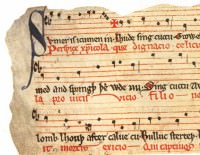Musical Characteristics of the Songs Attributed to Peter of Blois (c.1135-1211)
Lyndsey Michelle Thornton
Master of Music, The Florida State University (2007)
Abstract
Toward the end of the twelfth century, moral conflict was rampant in the Catholic Church regarding the conduct of all levels of the ecclesiastical hierarchy. There was acerbic criticism of the profligate bishops and archbishops who formed the upper echelon of clerical life, and much of this censure came from within the ranks of the clergy. One of the most interesting critics of the higher clergy is Peter of Blois, who had served such clerical posts as Archdeacon of Bath and London. He criticized the behavior of everyone from archbishop to altar boy in his letters and poetry, but the latter oeuvre also expresses his concessions to the inner conflict that he faced as a result of his choice to serve God. A double standard of morality is prevalent in both the prose and verse works of Peter of Blois and is often one of the identifying factors in support of attributions of his authorship. He condones vice in moderation during youth but advocates repentance in old age. While there is an increasing amount of scholarship that treats either Peter’s song texts or the music of the corpus of Notre Dame conductus, specific research into the music of Peter’s songs is not readily available.
This study examines the musical characteristics of the songs of Peter of Blois and their relationship to the texts within the manuscript tradition of his works, placing them within the context of the Twelfth-Century Renaissance. Because of the cohesion of the group in the Florence MS and the clarity with which they can be transcribed, these songs will be the primary focus of musical discussion. Through analysis of the musical components of the songs from Florence fascicle X that can be attributed to Peter with a significant amount of certainty, and through comparison with those known to have been written by Peter’s contemporaries, such as Walter of Châtillon and Philip the Chancellor, I will define a musical style that is characteristic of Peter’s songs in addition to providing evidence for new attributions.
Musical Characteristics of the Songs Attributed to Peter of Blois (c.1135-1211)
Lyndsey Michelle Thornton
Master of Music, The Florida State University (2007)
Abstract
Toward the end of the twelfth century, moral conflict was rampant in the Catholic Church regarding the conduct of all levels of the ecclesiastical hierarchy. There was acerbic criticism of the profligate bishops and archbishops who formed the upper echelon of clerical life, and much of this censure came from within the ranks of the clergy. One of the most interesting critics of the higher clergy is Peter of Blois, who had served such clerical posts as Archdeacon of Bath and London. He criticized the behavior of everyone from archbishop to altar boy in his letters and poetry, but the latter oeuvre also expresses his concessions to the inner conflict that he faced as a result of his choice to serve God. A double standard of morality is prevalent in both the prose and verse works of Peter of Blois and is often one of the identifying factors in support of attributions of his authorship. He condones vice in moderation during youth but advocates repentance in old age. While there is an increasing amount of scholarship that treats either Peter’s song texts or the music of the corpus of Notre Dame conductus, specific research into the music of Peter’s songs is not readily available.
This study examines the musical characteristics of the songs of Peter of Blois and their relationship to the texts within the manuscript tradition of his works, placing them within the context of the Twelfth-Century Renaissance. Because of the cohesion of the group in the Florence MS and the clarity with which they can be transcribed, these songs will be the primary focus of musical discussion. Through analysis of the musical components of the songs from Florence fascicle X that can be attributed to Peter with a significant amount of certainty, and through comparison with those known to have been written by Peter’s contemporaries, such as Walter of Châtillon and Philip the Chancellor, I will define a musical style that is characteristic of Peter’s songs in addition to providing evidence for new attributions.
Click here to read this thesis from The Florida State University
Subscribe to Medievalverse
Related Posts